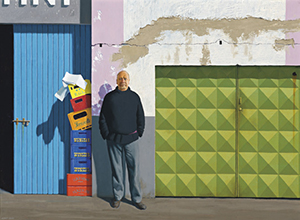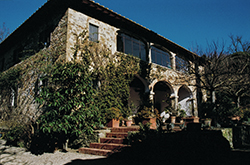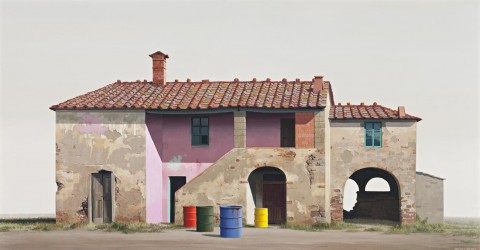THE TUSCAN FARMHOUSE, 1980
JEFFREY SMART
oil and synthetic polymer paint on canvas
71.0 x 134.0 cm
signed lower right: JEFFREY SMART
bears inscription on frame verso: A.G 10
Australian Galleries, Melbourne (label attached verso)
Private collection, Melbourne, acquired from the above in 1982
Jeffrey Smart, Australian Galleries, Melbourne, 26 October – 7 November 1981, cat. 10 (as ‘Tuscan Farm House’)
Millar, R., ‘Parr’s black beauties’, The Herald, Melbourne, 29 October 1981, p. 30
Newman, J., ‘The surreal images of Smart’, The Age, Melbourne, 3 November 1981, p. 21 (illus.)
Malouf, D., ’Jeffrey Smart: Recent Works’, Art International, Lugano, vol. XXV, No. 7/8, 1982, p. 66 (illus.)
Quartermaine, P., Jeffrey Smart, Gryphon Books, Melbourne, 1983, cat. 775, pp. 85 (illus.), 117
McDonald, J., Jeffrey Smart: Paintings of the ‘70s and ‘80s, Craftsman House, Sydney, 1990, cat. 226, p. 160
Drawing for ‘Tuscan Farmhouse’, 1980, ink on paper, 30.0 x 40.0 cm, private collection
Study for ‘Tuscan Farmhouse’, 1980, oil on canvas, 45.0 x 60.0 cm, private collection
We are grateful to Stephen Rogers, Archivist for the Estate of Jeffrey Smart, for his assistance with this catalogue entry.
smart portrait.jpg

In 1965, Jeffrey Smart returned to Italy to live. Six years later, he settled in an old farmhouse at Posticcia Nuova, near Arezzo in the heart of Tuscany. Close to the great works of the Renaissance master Piero della Francesca, whose passion for stillness, light and geometry so inspired him, it was to be his home for the rest of his life. Many recall the beauty of the landscape, the nightingales, olive groves and sheep, crowned by the villa and gardens, in turn enlivened by the personality of its host – witty, gregarious and gifted. The Tuscan Farmhouse, 1980, while based on another nearby, is redolent with such memories and recollections. Peter Quartermaine, in an early monograph on Smart, wrote: ‘There is no mystery to the farmhouse: its perspectives neither puzzle nor deceive and we can attribute a practical use to every detail, even the oil drums. This transparency of surface lends the picture a silence which impresses and intrigues. Seeing the original building was a shock, almost a disappointment’.1 Smart’s mastery of presenting the familiar as unfamiliar is at the fore. We see it through Smart’s eyes, a masterpiece of isolation, enigmatic, mysterious. Its genesis was typical. As it progressed from ink drawing, through oil sketch to final painting, possibilities were detailed and determined to perfection. Stillness, which Smart likens to good design, leads to eye-catching, hard-edged exactitude. Married to light: ‘It’s always the light. [Smart said] Obviously it must be the light. Without light you don’t see anything’.2 Its inventive use, he added, ‘casting shadows and making shapes that never existed before’.3
For Smart, light is a metaphor, a revelation and a reality. As forms advance or recede, participants are placed as purposefully as those on a chessboard, dressed in colours enticing or resistant. And frontal directness flirts with deep shadows angled sharply. In The Tuscan Farmhouse the usual figures, which Smart says he employs to give scale, are replaced by oil barrels, another fascination.4 The anthropomorphic presence is as real as the magnificent geometry of the architecture and its echoing arches. All is set in splendid isolation against a precipitous skyline edge – enveloped in a timeless frisson – surreal. Standing alone, with reminiscences of other paintings reaching back to Wasteland II of 1945 in the collection of the Art Gallery of New South Wales, Sydney.
While Smart warns about reading too much into his pictures, he puts much there to be seen. It is part of the absorbing paradox that is Jeffrey Smart. Inspiration found in the everyday is the hallmark of his art. For him it is ‘To recrystallise a moment of ecstasy: ecstasy or a moment of feeling about something. Sometimes the feeling is not so much visual. Sometimes it’s a feeling about a certain place or area of Rome or Florence, or the country where there’s a garage’.5 This is carried over into the act of painting, for, as Smart says, ‘… the making of a picture is such pleasure’, a pleasure shared with the viewer.6
190152 - Supplementary Image copy.jpg

The preparatory ink drawing and oil study for The Tuscan Farmhouse were shown in Smart’s 1980 exhibition at Rudy Komon’s Sydney gallery, which also presented the classic, The Guiding Spheres II (Homage to Cezanne), 1979 – 80 (private collection). The Tuscan Farmhouse made its appearance in Smart’s following show at the Australian Galleries, Melbourne in 1981. Its prestige company included Portrait of David Malouf, 1980 (Art Gallery of Western Australia, Perth) and Night Stop, Bombay, 1981 (private collection). The two versions of Autobahn in the Black Forest (both private collections) had been painted in 1979 – 80, each heralding golden years of achievement.
In Melbourne, Ronald Millar writing for The Herald, referred to ‘Smart’s decaying Tuscan farms’,7 while Judy Newman in The Age commented on his surreal images, ‘Road signs, petrol trucks, autostradas –all trappings of 20th century life …’. She continued, ‘Even a petrol hose can take on a menacing, surreal aspect at the hands of this artist and a group of petrol drums standing in front of an old Tuscan farmhouse can appear vested with an ominous presence’.8
A singular art of meticulous clarity and allusions, impersonal and emotional, intellectual and sensuous, contemplative and poetic, balance and proportion, is weighed in scales of detachment. Jokes private to those less subtle, a sense of humour runs throughout. Of his objective reality? It is the persona, the actor’s mask worn to face the world.
1. Quartermaine, P., Jeffrey Smart, Gryphon Books, Melbourne, 1983, p. 85
2. De Groen, G., ‘Where the light must rule: Conversation between Geoffrey De Groen and Jeffrey Smart, Sydney – an excerpt’, Art and Australia, Sydney, vol. 19, no. 2, 1981, p. 190
3. ibid.
4. This fascination is such that in 1992 he devoted The Oil Drums (private collection) to them.
5. Smart, J., quoted in Pearce, B., Jeffrey Smart, The Beagle Press, Sydney, 2005, p. 8
6. ibid.
7. Millar, R., ‘Parr’s black beauties’, The Herald, Melbourne, 29 October 1981, p. 30
8. Newman, J., ‘The surreal images of Smart’, The Age, Melbourne, 3 November 1981, p. 21
DAVID THOMAS
